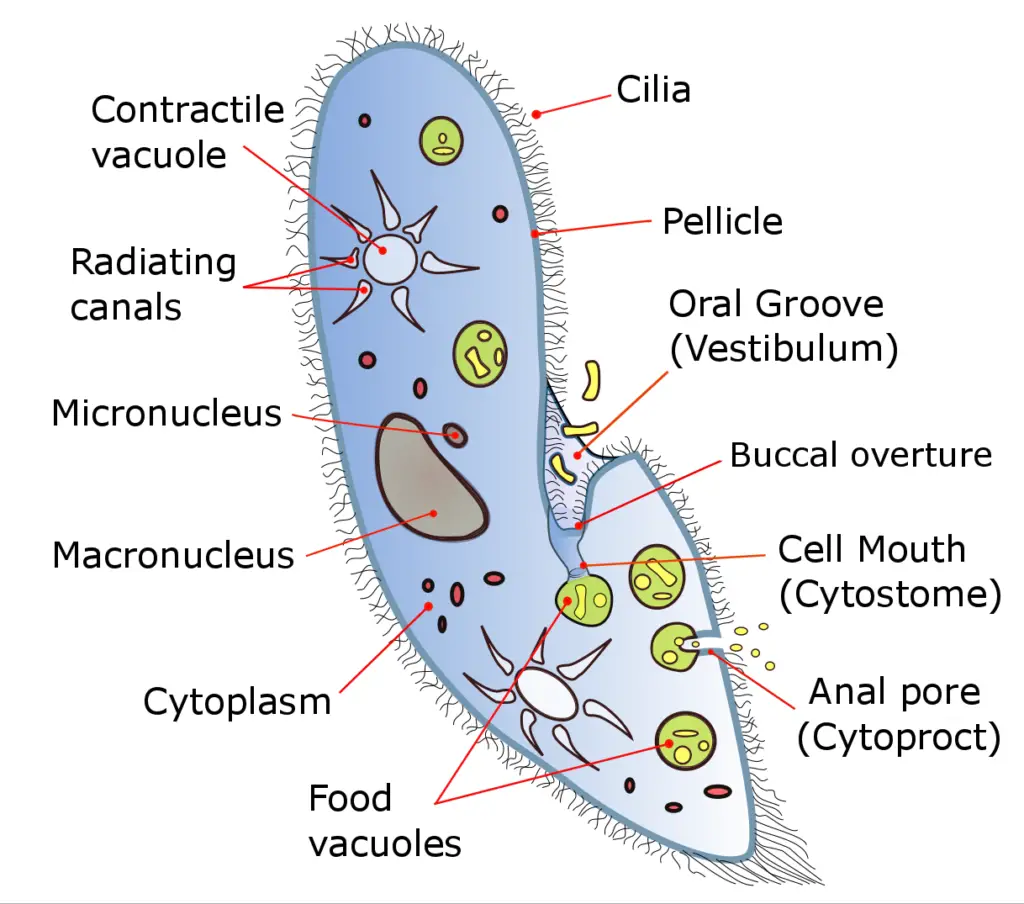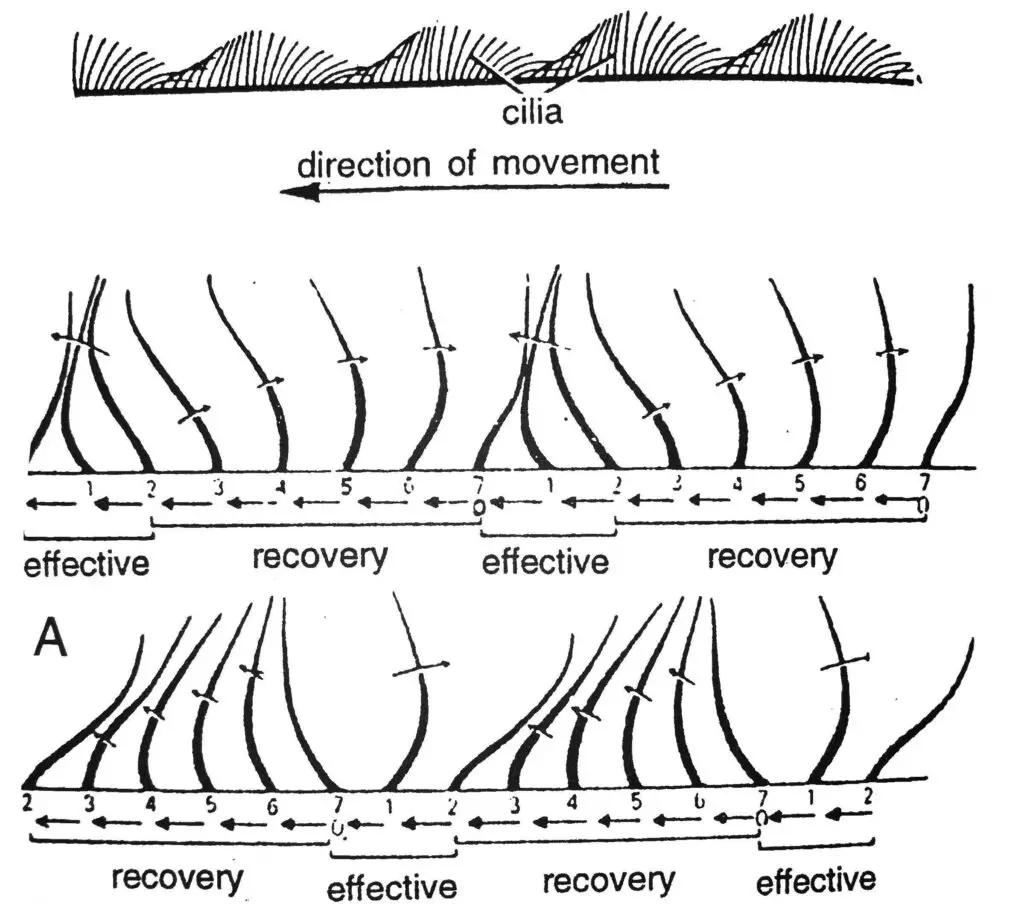How does Paramecium move? – (Locomotion & Movement in Paramecium)
Paramecium is widely distributed in freshwater ponds, pools, ditches, streams, rivers, lakes, reservoirs, etc. that contain a great deal of decaying organic matter.
All Parameciums are protozoans that move with the help of cilia that are present on their outer body surface. They are all called ciliates and are included in the subphylum Ciliophora.
Their locomotive organs are cilia that are arranged covering the whole outer body of the paramecium in definite longitudinal rows.
Cilia are those numerous hair-like tiny and fine projections that covered the entire body surface. Each cilium measures 10-12 μm in length and 0.27 μm in diameter.
Parameciums move like boats with many paddles where the body of the Paramecium is the boat and the cilia are the paddles. There are about 10,000 to 20,000 cilia covering the whole body surface.
Paramecium do have a cell membrane with an outer protective pellicle that protects the cell membrane.
In between the pellicle layers, there are hexagonal areas. Each cilium (plural: cilia) comes out through each of the hexagonal areas.
Due to its aquatic dwelling, a Paramecium is able to propel and locomote itself by the various movements of cilia, which are arranged in tightly spaced rows around the outside of the body.
Scroll down this article to gain more information about the paramecium, and its mechanism of locomotion and movement. So, let’s get started…

How does paramecium move: Locomotion & Movement in Paramecium
Paramecium is really very fast swimmers due to the presence of their streamlined body which enables them to better swim in the water with a minimum amount of friction.
Their cilia make them wonderful swimmers. Moreover, their speed of locomotion is almost equal to the distance that they can cover at the rate of about four times their own body length per second.
Some species like P. multimicronucleatum and P. caudatum are so fast that you must add a thickening agent to the water to slow their movement down enough to study it.
Their kind of rapid swimming is facilitated by the beating of very fine hair-like cilia that covers the animals’ entire body surface. They can actually move with the speed of 1500 μm per second.
★ Ciliary Beats: Movement of Paramecium due to the Cilium oscillations
The cilia of Paramecium is characterized due to its oscillatory movements. During the movement of Paramecium, it is seen that a cilium oscillates like a pendulum.
The movement of the cilia is in a wave-like fashion called metachronal rhythm. A metachronal rhythm is also called a metachronal wave that refers to wavy movements produced by the sequential action of cilia that produce the appearance of a traveling wave.
Each of the metachronal rhythmic oscillations of the cilium comprises a fast effective stroke and a slow recovery stroke. The effective stroke and recovery stroke can be well-seen in all cilium of the Paramecium.
You will notice that a ciliary beat cycle consists of an effective stroke in which the extended cilium makes an oar-like movement towards one side, and a recovery stroke in which the cilium moves back by propagating a bend from base to tip.
During the effective stroke or the strong backward lash, the cilium becomes slightly curved and rigid which is normal, and then it strikes the water like an oar. This makes the body to propel forward in the opposite direction of the stroke.
The recovery stroke is followed just immediately after the effective stroke has just ended, and it brings the cilium again into the position for the next effective stroke.
The cilia being arranged in a longitudinal row on the pellicle of the Paramecium beat in a characteristic wave-like fashion beginning at the anterior end and progressing backward.
All the cilia of a transverse row beat simultaneously or synchronously one after the other. Meaning that one cilium moves ahead of the one behind it.

★ Mode of Swimming of the Paramecium
Paramecium moves and locomote i.e. they swim in water with the help of its cilia. It doesn’t locomote in a straight track but rotates spirally along a left-handed helix as it moves forward.
Various theories say that in Paramecium the cilia moves in a coordinating system one after the other due to the contraction of the peripheral fibres located within them using the energy supplied by ATP.
It happens because firstly the cilia beat obliquely towards the right so that the animal can rotate over to the left on its long axis.
Secondly, the cilia of oral groove strike obliquely and more vigorously so as to turn the anterior end continually away from the oral side and move in circles.
The combined effect of the first beat towards the right and the second strike causes the movement of the animal along a fairly straight path, rotating about its axis in an anti-clockwise direction.
Whereas, during the backward movement of the Paramecium you will find it to move in a straight course as the metachronal rhythmic oscillations of the cilium pass from the anterior end backwards. During this backward movement time, the effective stroke is carried out anteriorly.
Some quick facts about movement and locomotion in Paramecium
1. A Paramecium propels itself by whiplash movements of the cilia. These cilia are arranged in tightly spaced rows around the outside of the body’s pellicle.
2. The beat of each cilium has two phases: a fast “effective stroke” and a slow “recovery stroke”.
3. During the fast “effective stroke” the cilium is relatively stiff. Whereas, during the slow “recovery stroke” the cilium curls loosely to one side and sweeps forward in a counter-clockwise fashion.
4. The movement of cilia looks like a “ciliary carpet” that resembles an effect like that of the wind blowing across a field of grain.
5. The Paramecium spirals through the water as it progresses and moves around.
6. Paramecium shows an “avoidance reaction” when it encounters an obstacle as it moves forward. As per the avoidance reaction when the Paramecium encounters an obstacle the “effective stroke” of its cilia is reversed and the organism swims backward for a brief time, before resuming its forward progress. If it runs into the solid object again, it repeats this process, until it can get past the object.
7. Cilia are used not only in locomotion but also during feeding. Paramecium are heterotrophs. To gather food, the Paramecium makes movements with cilia to sweep the prey organisms, along with some water, through the oral groove (vestibulum), and then directly into the cell.
8. It has been calculated that a Paramecium expends more than half of its energy in propelling itself through the water. Arginine-kinase and Adenylate-kinase activities are detected in the cilia that help in providing ATP for the ciliary movement.
What is “avoidance reaction” in Paramecium’s locomotion and movement?
Avoidance reaction is a type of reaction that is seen when a Paramecium during its forward swim in water comes across an obstacle. The term “avoidance reaction” is often used in the description of the movement of Paramecium.
Avoidance simple means to avoid and so the reaction that causes the avoiding stimuli is the avoidance reaction. This reaction helps the cell avoid obstacles and causes other objects to bounce off the cell’s outer membrane.
The paramecium does this reaction by simply reversing the direction in which its cilia beats. This results in stopping, spinning, or turning, after which point the Paramecium resumes swimming forward.
It has also been noticed that if multiple avoidance reactions follow one another, it is possible for a paramecium to swim backward, though not as smoothly as swimming forward.
This avoidance reaction is really very helpful as it helps the organism for changing its direction as soon as it encounters an obstacle that may also be a predator. In such a case, the cilia immediately start beating in the opposite direction.
This helps the paramecium to avoid the predator. Remember that this avoidance reaction only occurs when the cell hits an obstruction, or when it gets mechanical stimuli thus forwarding the avoidance stimuli signaling the organism to stop and rotate and gradually move backward.
This process will continue until the cell is able to negotiate its way around the obstruction.
Movement of Paramecium cells is caused by the control of calcium ions inside the cell and membrane potentials.
The simplest explanation for the avoidance reaction is that membrane potential controls the influx of calcium ions, which regulates the beat frequency and angles of cilia on the surface of the cell.
